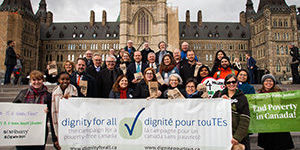The Federal Government’s 2021 $30 billion budgetary commitment to build a Canada-wide system of early learning and child care services begins a hopeful chapter in the decades-long struggle for high-quality child care.
The COVID-19 pandemic has called attention to the child care crisis that families across the country have faced for years. In short, there is not enough high quality, reliable, regulated child care for families, with spaces for less than three out of 10 children under six (26.9 per cent). The lack of services most impacts the 78 per cent of mothers with children aged three to five who are in the labour force, as the Childcare Resource and Research Unit’s ECEC in Canada 2019 reports. For the one in five children under the age of six living in poverty, the lack of access to child care is a major barrier to parents’ economic independence, according to Campaign 2000’s 2020 Report Card on Child Poverty in Canada. Most child care is not affordable, with fees in excess of more than a year of university tuition, as the Canadian Centre for Policy Alternatives demonstrates. Moreover, the child care workforce, the heart of the caring, learning environment who support parents and ensure quality, is under-valued and under-paid.
What is the federal plan for early learning and child care?
The 2021 federal budget addresses the dual crisis of affordability and availability/accessibility in the short and long term. By 2022, the commitment is to reduce average fees for all regulated child care services by 50 per cent (outside of Quebec) and by 2025-26 to provide an average parent fee of $10 per day. In addition, expansion of high quality services—in centres and in home-based care—will be predominantly in the non-profit sector. A key component is working with Indigenous communities and partners, using the Indigenous Early Learning and Child Care Framework as a foundation. The federal allocation proposes an additional $2.5 billion over the next five years with increased annual program funding beginning in 2027-28.
Unlike previous child care initiatives, the government will table legislation in Fall 2021 to secure its on-going ELCC commitment as the budget outlines. By embedding the principles of a Canada-wide system of child care into law, the government will formalize this “transformative project on a scale with the work of previous generation of Canadians who built a public school system and public health care.”
Why building a Canada-wide system of ELCC services makes more sense than tax measures
Public responses to the federal government’s plan for early learning and child care showcased widespread support from families, academics, economists, researchers, business leaders, editorial writers and early years educators. Advocates, parents groups and women’s groups viewed the sizeable financial commitment as a game-changer that will produce a system of affordable services while supporting women’s equality and labour force participation. In contrast, Conservative Opposition Leader Erin O’Toole favours “putting parents in the driver’s seat” and giving options to parents, Premier Jason Kenney dismissed the plan as “one-size-fits-all” and Cardus, a faith-based research organization, repeated its preference for individual payments to parents.
It’s important to remember that Canada has robust mechanisms to transfer money to parents. Since its first iteration in 1998, the Canada Child Benefit has been a non-taxable, geared-to-income monthly payment (maximum of $563 for children under six) that assists about 90 per cent of families with the cost of raising children. Since 1972 the Child Care Expense Deduction (CCED) has been available to eligible parents who take on child care expenses (up to $8,000 per year for children under seven) in order to work or study. Neither of these policies has led to an adequate level of child care services.
What does building a system of ELCC services mean?
Building a system is no easy task, but one that is essential to meet the needs of families and the economy. Currently, child care in Canada is market-driven, characterized by low levels of demand-side public funding (ie. vouchers, tax measures, individual parent fee subsidies), heavy reliance on parent fees, and limited public management and planning. Child care is treated as a commodity not an entitlement for children, is not systematically planned or treated as a public good, nor is it part of the social infrastructure, as schools and libraries are.
Building a system requires direct funding to defined child care services. Planners and decision-makers, in concert with parents and local communities in small and large urban and rural areas, will now have the resources to create and sustain reliable, high-quality child care options for parents to choose from—in centres, homes and workplaces—at an affordable rate. This emerging system will also support the economy whose workers need child care from coast to coast to coast.
Photo credit: Aaron Burden





